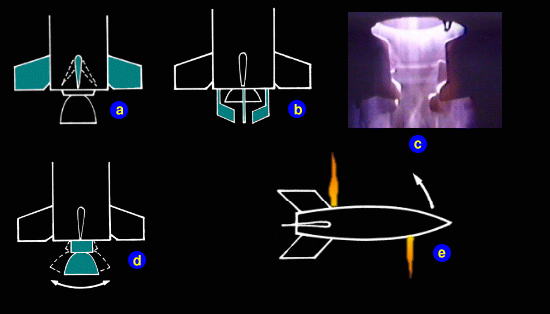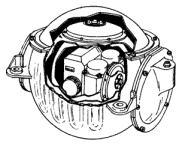rocket guidance







|
As long as the rocket is in the atmosphere, steering it isn't very different from steering an airplane. Just as an airplane has adjustable surfaces -- rudders and so forth -- on its wings and tail, a rocket can be fitted with tailfins that have the same adjustable control surfaces (Fig. 1a). There are two obvious problems with this method. First the rocket must be going fast enough to provide enough airflow. At liftoff the rocket doesn't move fast enough, and that's when you need the most control. Second, rockets for space travel need to be able to operate in a vacuum. Nevertheless most rocket boosters and nearly all model rockets employ some form of passive aerodynamic stability. The fins on a rocket, even if they don't move, help keep the rocket pointed along its direction of travel.
But the best way of directing rocket exhaust is to direct all of it. That means swiveling the engine itself by mounting it in a gimbal (Fig. 1d). Since the entire thrust is directed, it doesn't need to swivel all that much -- only a few degrees. Most modern rockets, including the space shuttle main engines, use gimballed engines. A rocket that must control its attitude without firing its main engine uses small RCS thrusters to effect a rotation. These can be used while the rocket is firing to correct the attitude errors caused by off-axis thrust (Fig 1e). The disadvantage to this method is that the rotation rate can generally only be changed by a fixed amount since RCS thrusters have a fixed thrust.
Being able to control the orientation of a rocket is only half a solution. A steering wheel is no good without a driver and a road to follow. We can use a gyroscope mounted in a gimbal to provide a fixed reference for orientation. The gyroscope will always maintain the same orientation in space regardless of how the spacecraft turns. This same principle operates the artificial horizon instrument in a conventional airplane.
Another advantage to using digital computers is that by combining gyro information with altitude, precise timing, and speed, the rocket can be made to fly exactly along a preplanned trajectory. It need not go straight up, or even in a straight line. Some of this could even be accomplished prior to digital computing. The V2 rocket used timers and more simple electronics to achieve a ballistic trajectory for use as a weapon. |



